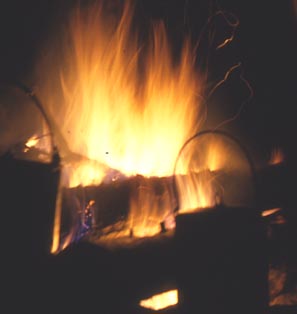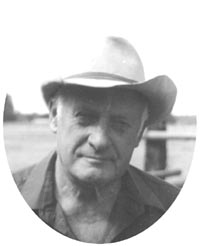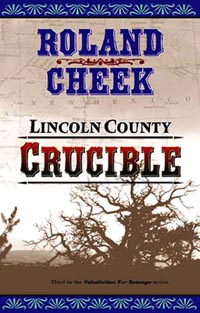a weblog sharing info on outdoor skills and campfire musing by a guy who spends a bunch of time in pursuit of both
CULTURE
WHERE -
TALES ARE TOLD OF
Welcome to Roland Cheek's Weblog
Roland is a gifted writer with a knack for clarifying reality. Looking forward to more of his wisdom
- Carl Hanner e-mail
While still in high school, fifty-some years ago, the rumor was that a particularly good-looking girl smoked marijuana. I made a date with her because I wanted to push the envelope and learn more. She didn't smoke any weed that night and, in fact, had me take her home by 10pm (so, I later discovered, she could entertain her evening's 2nd date). The upshot of all the above? A half-century later, I still don't know what marijuana smells like. Nor have I discovered a use for any other drug, perhaps because the addiction I acquired was a love for the outdoors. Maybe I'm lucky on so long-ago evening that the girl I pursued had a hotter date.
To acess Roland's weblog and column archives
Tip o' the Day
I've slipped in and out of my saddle a few thousand times, so I know it fits. But like most other horsemen, I don't know how to help anyone else find just the right saddle to fit them.
So to learn more about picking a saddle that fits, I asked a fellow whose advice I've respected enormously for well over forty years. Larry Gleason is a retired Ronan saddlemaker who also guided a few of my hunters during years I spent leading others to adventure in the Bob Marshall Wilderness.
"Find a saddle that fits, huh? Larry said. "Maybe that depends on how much a person plans to use it and what for."
I asked Larry to explain.
"There are three kinds of seats: cantle, center seat, and level seat. In a cantle seat, the front is high and it's deep back by the cantle. Center seats slope to the middle from both pommel and cantle. They're probably best for most people, expecially trail riders. Level seats are mostly for cutting horses, used with forward stirrups."
"How about the old style?" I asked. "High horn and cantle?"
"Again, that might depend on what you're doing with it. A person can get hurt with a tall horn or high cantle if their horse begins plunging around. Tall horns are usually double-dally horns that are for roping and team roping. Not much good for anything else. All a rider needs is a horn that's tall enough to get a good grip on."
"How about a high versus low cantle?"
"Should be high enough to come up on the buns, but not so high you can't swing in and out easy. Again, a shovel cantle can be a dangerous thing if you're straddling a rank horse. I'd say not over a 4-inch cantle."
"What about seat size?" I asked.
"Trees are measured from the base of the horn to the top of the cantle. But how comfortable you sit will also depend on location of swells. If swells are low, it'll spread your legs enough to be uncomfortable. Higher swells might allow you to slip easily into a smaller tree size.
I asked about stirrups?
"Most people say proper riding posture should be to sit erect and comfortable. You should be able to look down past your knees and see the tips of your toes, with the heel lower than the toe. By riding in this manner, most folks will have better leg contact with their horse."
Larry's advice is to buy only good quality saddles with a rawhide or fiberglass tree.
Knowing what the answer would be, I still asked about padded seats. The old saddlemaker stared steadily at me for several moments, then said, "Next quesion."
Thanks, Jane. I'm really enjoying Roland's stories -- this one about three travelers in the Bob with a wheelchair was amazing! / email from Fran Brinkley
* * *
Love your books. They are so much better than Louis L'Amour's / email from Josh Richmond
* * *
I found it. I liked it. And I sent a copy to Major Mitchell / email from Pat Nipper
ALL ABOUT EASTER -- MOON LORE YOU CAN USE
How many of you know how the date for Easter is determined? All of us know it varies a great deal from year to year. Occasionally Easter will come, as with this year in March, another time after April's mid-point. Why such variation? After all, Christmas is always December 25, and few of us are puzzled about the date for Independence Day. Why such complications for Easter?
Here's why:
The date to set Christ's resurrection is actually set by the phases of the moon. historians tell us that early Christians, canny creatures that they were to survive the best efforts of Roman Emperors, barbarian warlords, and shifty-eyed eastern potentates to annihilate them, simply adopted the date of an early pagan ritual as their time to celebrate the resurrection. Then, they made a conscious effort to blend with the woodwork.
The handy pagan ritual chosen as a facade for Christian worship was in dedication to the goddess of spring, a mythical lady named Oestrus. Even her name was used in the charade, and "Oestrus" eventually became "Easter."
That's interesting, you might say, but it still doesn't explain the wide range of dates for Easter.
Okay, consider that the Pagan celebration for Oestrus always fell on the first full moon after the sun had moved half-way on its annual swing to the north--March 20th (the full moon fell on March 21st this year). Thus today, Easter always falls on the first Sunday after the first full moon after the first day of spring. If that all sounds complicated, blame it on Augustus Caesar, Attila the Hun, or Timur the Terrible.
The moon, of course, has long been blamed for both the eroticism and mysticism of the astrologically inclined. Roman Bacchanalian orgies waxed and waned with the rise and fall of the moon. So, too, did the ancient Druids practice their mystic rites during full moons.
Pagan pratices weren't only affected by the moon's rise and fall. Entire oceans feel its pull with tides--sometimes the sun and moon line up to exert extra-gravitational pull of massive might. Such is the effect of tides that electricity can be generated from its energy in tidal estuaries around the globe.
Lovers moons, they're sometimes called. and who can deny its influence when one is young, virile, and in company with an attractive person of the opposite sex?
But the moon serves much more purpose than to cleanse beaches and woo lovers, or even produce electricity. My father and mother watched the moon for signs of impending weather changes. A ring around the moon, for instance, was to them a signal of coming rain. The wider the ring, the farther away that weather change would be.
Was their prognosis an "old wives tale?" Apparently not. The ring is actually caused by clouds of vapor or frost high in the atmosphere. That vapor is pushed ahead of storm fronts. In summer, such a moon is said to be "taking a bath," in winter it's "fighting through snowdrifts."
Old wives tales were the bane of my youth. That my parents could believe them was a source of embarrassment to me--an enlightened being of another generation. But as the years pass, I'm finding that perhaps not all of my parents old wives tales were dumb.
I'm not sure what all the foregoing means . . . except that I'm not nearly as smart as I once thought I was; and I can now make a projection for the date on which Easter will fall--provided I can find a moon cycle table for 2009.
Roland Cheek wrote a syndicated outdoors column (Wild Trails and Tall Tales) for 21 years. The column was carried in 17 daily and weekly newspapers in two states. In addition, he scripted and broadcast a daily radio show (Trails to Outdoor Adventure) that aired on 75 stations from the Atlantic seaboard to the Pacific Ocean. He's also written upwards of 200 magazine articles and 12 fiction and nonfiction books. For more on Roland, visit:
www.rolandcheek.com
Recent Weblogs
Tuesday, March 25, 2008
for more info about these and other Roland Cheek books
There's a bunch of specific info about Roland's books, columns, archives and radio programs. By clicking on the button to the right, or below left, one can see Roland's synopsis of each book, read reviews, and even access the first chapter of each of his titles. With Roland's books, there's no reason to buy a "pig in a poke."
for detailed info about each of Roland's books
Read Reviews
Read their first chapters
For interested educators, this weblog is especially applicable for use in outdoor / nature classes, as well as for journalism students.
Roland, of course, visits schools. For more information on his program alternatives, go to:
Books 2 & 3 are set amid New Mexico's violent Lincoln County War
Book four in the Valediction For Revenge series, Gunnar's Mine, is set in Colorado mining country, as is the sixth and final book in the series, The Silver Yoke
Book five in the series is Crisis On the Stinkingwater is set around present-day Cody, in what is now called Wyoming's Shoshone River Country
I knew you were a good writer, but I never before put you in the class of Michener and Clancy. You spin a good yarn and don't let it drop for a minute. You handle dialogue extremely well, and the action scenes are outstanding. You have no reason to venture so carefully into the world of novelists.
- Jack Oliver / Pittsburgh, PA
Next Week:
OMNIVOROUS URSIDS
www.campfireculture.com
to send this weblog to a friend
to tell Roland what you think of his Campfire Culture weblog
source links for additional info
to visit Roland's newspaper columns and weblog archives








